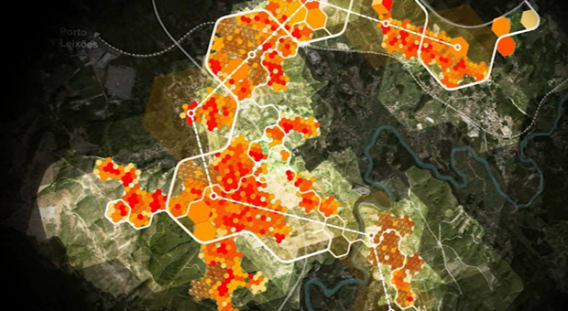
















(Originally published on FastCompany.com, August 23, 2010.)
When did Silicon Valley become so obsessed with building cities? Last month it was Cisco’s SVP of strategy Inder Sidhu describing the company’s smart city play as the $36 billion company’s “biggest opportunity.” Then, at the inaugural Techonomy conference a few weeks ago, an all-star roster of techies, VCs, and scientists pondered “cities as solutions.”
Physicist and former Sante Fe Institute president Geoffrey West practically stole the show with his talk on urban metabolisms. Cities are like organisms, he explained, except they grow much faster and much bigger than anything living – in fact, there appears to be no upper limit to their size or propensity for innovation… or disaster. “Urbanization is the problem,” he said, “and it can also be the solution.”
These being Silicon Valley types, it was clear what that solution should be. “Copying 20th century cities in Dubai and Shanghai is crazy,” said former Sony chairman Nobuyuki Idei in yet another session. “We need… a city OS” – a single platform managing power, water, traffic, security and any other urban system you can think of.
Rest assured, Mr. Chairman, someone is working on it. But it isn’t Cisco, IBM, HP, Microsoft, or any other tech heavyweight. In fact, in the course of reporting my story on New Songdo City last fall, representatives of each company pooh-poohed the idea of a purpose-built urban operating system. They believed one would emerge eventually, albeit as the result of a messy convergence of competing standards – you know, the way things work in the real world. Leave it to a five-year-old start-up few people heard of to challenge that notion and to build its own smart city from scratch in the hills of Portugal near Porto – “PlanIT Valley.”
Living PlanIT (pronounced “planet”) is the brainchild of Steve Lewis and Malcolm Hutchinson, a pair of IT veterans who met when Lewis was still a top executive on the .NET team at Microsoft. Their ambition is twofold: to build a prototype smart, green city in Portugal that can be rolled out worldwide, and to drag the construction industry into the 21st century.
The latter may be the more audacious of the two. While plenty of companies have jumped on the smarter city bandwagon (as I’ve written about ad nauseum), no one has sought to make the construction business look more like the technology one.
“It’s a bit of a bloodbath really,” says Lewis, who began studying it while still at Microsoft. “They’re using techniques older than God. All of the technology is being used on the design end. No one can look into the future and ask ‘If I put better glass into this building, what does that do for energy efficiency down the road?’ You have developers building to do a quick flip, and eventually the building becomes so inefficient and so expensive to fix they have to knock it down. There’s no process and no lifecycle management. The industry is fragmented and the consolidation that’s happened everywhere else hasn’t happened here.”
A Harvard Business School case study (pdf) published earlier this year echoed this view. Despite being a $4.6 trillion global industry, construction firms have had little incentive to integrate, consolidate, or otherwise become more productive. While non-farming industries have made productivity gains averaging 80% since the 1960s, the construction industry has become 20% less productive over that span. “Studies suggested that up to 75% of construction activities typically added no value,” the authors noted.
This is astounding (although not at all surprising) considering buildings “accounted for nearly 40% of the total energy consumption in the United States, including 70% of the country’s electricity, and 38% of carbon emissions.” (Some estimates have put it as high as 50%.) Construction materials accounted for a whopping 60% of solid, non-industrial waste. “Most of it ends up in landfill,” Lewis says. “They either broke it or over-ordered it.”
His solution is simple – and overwhelmingly ambitious. First, streamline the process by applying the same lean manufacturing techniques and supply chain integration that’s been common in the automotive and aerospace industries for years. Lewis and his team have spent the last five years talking to Northop Grumman, Toyota, and Ford (among others) about “mass manufacturing and mass customization,” he says. “How do you get the aesthetics and variability right while at the same time keeping consistent quality?” He envisions construction companies which look more like the computing industry’s original design manufacturers (ODMs), building modular, plug-and-play components ordered from a catalog and slotted into a city’s Urban Operating System – both of which will be owned by Living PlanIT.
The second piece is to build an “ecosystem” of partners including Cisco, Accenture, the U.K. engineering firm Buro Happold, the project management software company Aconex, and McLaren Electronic Systems, which sells the onboard sensors for Formula One racing. Living PlanIT has signed or in talks with 300 such partners so far, and hopes to eventually sign 14,000. (Lewis says to look for the next batch of announcements in September).
Together, they’ll fill in the blanks in Living PlanIT’s plan to code cities like software – in which buildings, sensors, and traffic apps alike are connected through the cloud. All the company will own is the Urban OS – the glue in its urban fabric – and the process, from drafting blueprints to “decommissioning” an obsolete building like you would junk a server.
The company believes it’s the only way to achieve the efficiencies necessary to make a significant dent in cities’ carbon footprints. “Unless you’re thinking simultaneously about the technology, Urban OS, and the construction process, you’re going to end up with a sub-optimal solution,” argues Robert Eccles, the Harvard Business School professor who co-wrote the case study and has since joined its board.
Plus, it’s good business. “You create a platform, you license it to partners, they augment it, they drive it, and we pick up a royalty,” Lewis says. “We provide a software model to the entire industry,” and everyone’s profit margins soar. That’s the plan, anyway.
Because the difference between cities and software is that sooner or later, you have to compile your apps in atoms, not bits. Which brings us to “PlanIT Valley,” the $19 billion instant city outside Porto, Portugal. In 2008, the company began acquiring 1,670 acres, a footprint comparable to Korea’s New Songdo—which is in turn roughly the size of downtown Boston. Full build-out is scheduled for 2015, by which time PlanIT Valley should have a population of around 150,000 – nearly all of whom will work in R&D for Living PlanIT’s partners. (Cisco signed a deal to build a technology innovation center there in June.)
In other words, the city’s residents will experiment on themselves. “They don’t want a campus, they want a city,” Lewis says. “They need to send their kids to school; they need to be entertained. You end up with a brilliant R&D platform – you live in it, you improve it, you market it. If [a customer] says, ‘I want a medical clinic,’ we already have one. We backed into building PlanIT Valley based on customers’ demands.” It’s purely a prototype for the instant cities Living PlanIT hopes to sell in China and India – which need new ones by the hundreds, built faster and green and smarter than any city that’s come before. But first Lewis hopes to announce an urban infill project in a major European city this fall, and another in the U.S. within six months.
“What I find troubling as an academic and as a citizen of the world is whether enough innovation at this scale is going to happen to solve this problem, because it isn’t going away,” says Eccles. “The real problem is making sense of this market and learning how to finance it. We need to come up with a business model for doing this. To me, that’s their crown jewel – this completely fresh framing. It’s not, ‘build it, and will they come?’ It’s ‘Let’s give them reasons to come.’ No one has ever done that before and that is what Living PlanIT is trying to do.”
Not quite. Cisco signed a deal with the Kremlin earlier this summer to help create a purpose-built “Silicon Forest” outside Moscow, and New Songdo as it was originally conceived was designed as a laboratory for many of the same sensor technologies Living PlanIT intends to develop. In fact, the New America Foundation’s Parag Khanna touts Songdo as the template for future cities in the new issue of Foreign Policy.
But PlanIT Valley is the first city conceived by technologists, for technologists, in which the architecture and urban planning are all but beside the point. (“Architects are missing a big trick not thinking they need to be more engaged with the business and technology communities,” Eccles says. “The world is passing them by.”) And they’re hardly the first to apply the reigning technology paradigm of their day to urban planning. “We shall solve the City Problem,” Henry Ford once wrote, “by eliminating the City,” and succeeding in doing just that in Detroit.
In order to solve the world’s City Problem, Living PlanIT is betting, we must dematerialize the city, translate it to code, make perfect copies, and then scale it to whatever size we need. Soft City has become the Software City.

» Folllow me on Twitter.
» Email me.
» See upcoming events.

Greg Lindsay is a generalist, urbanist, futurist, and speaker. He is a non-resident senior fellow of the Arizona State University Threatcasting Lab, a non-resident senior fellow of MIT’s Future Urban Collectives Lab, and a non-resident senior fellow of the Atlantic Council’s Scowcroft Strategy Initiative. He was the founding chief communications officer of Climate Alpha and remains a senior advisor. Previously, he was an urban tech fellow at Cornell Tech’s Jacobs Institute, where he explored the implications of AI and augmented reality at urban scale.

----- | January 22, 2024
The Future of Generative AI in Architecture, Engineering, and Construction
----- | January 1, 2024
----- | August 3, 2023
CityLab | June 12, 2023
Augmented Reality Is Coming for Cities
CityLab | April 25, 2023
The Line Is Blurring Between Remote Workers and Tourists
CityLab | December 7, 2021
The Dark Side of 15-Minute Grocery Delivery
Fast Company | June 2021
Why the Great Lakes need to be the center of our climate strategy
Fast Company | March 2020
How to design a smart city that’s built on empowerment–not corporate surveillance
URBAN-X | December 2019
CityLab | December 10, 2018
The State of Play: Connected Mobility in San Francisco, Boston, and Detroit
Harvard Business Review | September 24, 2018
Why Companies Are Creating Their Own Coworking Spaces
CityLab | July 2018
The State of Play: Connected Mobility + U.S. Cities
Medium | May 1, 2017
Fast Company | January 19, 2017
The Collaboration Software That’s Rejuvenating The Young Global Leaders Of Davos
The Guardian | January 13, 2017
What If Uber Kills Public Transport Instead of Cars
Backchannel | January 4, 2017
The Office of the Future Is… an Office
New Cities Foundation | October 2016
Now Arriving: A Connected Mobility Roadmap for Public Transport
Inc. | October 2016
Why Every Business Should Start in a Co-Working Space
Popular Mechanics | May 11, 2016
Can the World’s Worst Traffic Problem Be Solved?
The New Republic | January/February 2016

January 31, 2024
Unfrozen: Domo Arigatou, “Mike 2.0”
January 22, 2024
The Future of Generative AI in Architecture, Engineering, and Construction
January 18, 2024
The Promise and Perils of the Augmented City
January 13, 2024